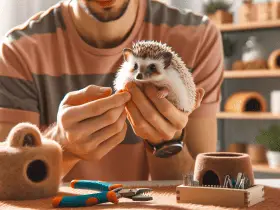Are you tired of your hedgehog being a loner? Well, look no further! We’ve got the perfect guide for you to socialize your prickly pal and create meaningful connections.
In this article, we’ll share our top tips for successful interactions with hedgehogs. From understanding their behavior to creating a comfortable environment, we’ve got you covered.
So let’s dive in and discover how to bond with your hedgehog like never before!
Key Takeaways
- Hedgehogs communicate through vocalizations, postures, and behaviors.
- Creating a comfortable environment is important for successful interactions.
- Use gentle handling techniques to build trust and comfort.
- Gradual introductions and playtime can help bond with your hedgehog.
Understanding Hedgehog Behavior
Understanding hedgehog behavior is crucial for successfully socializing your pet. Hedgehogs have their own unique way of communicating with us, and it’s important to be able to read their body language. By understanding hedgehog communication cues, we can create a stronger bond with our pets and ensure their well-being.
Hedgehogs communicate through various means, including vocalizations, postures, and behaviors. One common form of communication is huffing or hissing when they feel threatened or uncomfortable. This indicates that they are feeling defensive and may need some space. On the other hand, if your hedgehog is relaxed and content, you may hear them purring softly.
Reading hedgehog body language is another essential aspect of understanding their behavior. When a hedgehog feels relaxed and safe, they will uncurl from a ball position and explore their surroundings with curiosity. However, if they curl into a tight ball with quills erect, it means they are feeling scared or threatened.
Observing these behavioral cues can help us determine the right approach when socializing our hedgehogs. It’s important to respect their boundaries and provide a calm environment during interactions. By understanding their communication signals and reading their body language effectively, we can foster a sense of belonging for our beloved pets in our homes.
Creating a Comfortable Environment
When it comes to creating a comfortable environment for our hedgehog, there are a few key points to keep in mind.
First and foremost, we need to provide a safe play area where our hedgehog can roam freely without any potential hazards.
Additionally, familiar smells and sounds can help create a sense of security for our little friend.
Lastly, using gentle handling techniques is crucial in building trust and ensuring that our hedgehog feels safe and comfortable during interactions.
Safe Play Area
Creating a safe play area for your hedgehog is essential to ensure their well-being during interactions. When designing a hedgehog friendly habitat, it’s important to consider their unique needs and behaviors.
Start by choosing an appropriate enclosure that provides enough space for exercise and exploration. Opt for one with solid walls or bars spaced closely together to prevent any potential escapes. Line the bottom of the cage with a soft bedding material such as fleece or paper-based products, avoiding materials that can cause harm like cedar shavings.
Provide hiding spots like tunnels or igloos where your hedgehog can retreat when they need some alone time. Additionally, include toys and interactive elements such as tunnels, wheels, and puzzle feeders to stimulate their mind and keep them active.
Familiar Smells and Sounds
Familiar smells and sounds can help comfort your hedgehog in their play area, making them feel safe and secure.
Hedgehogs have a keen sense of smell, so incorporating familiar scents can create a calming environment for them. You can achieve this by placing items with your scent, such as worn clothing or bedding, in their play area. This will provide a sense of familiarity and belonging for your hedgehog.
Additionally, playing calming sounds can further enhance their experience. Gentle nature sounds or soft classical music are excellent choices to create a soothing atmosphere. Avoid loud or sudden noises that may startle your hedgehog as it could cause stress or anxiety.
Gentle Handling Techniques
Using gentle handling techniques can help establish trust and build a positive bond with your hedgehog. Understanding hedgehog behavior is crucial for successful interactions.
Hedgehogs are naturally cautious creatures, so it’s important to approach them slowly and calmly. Start by giving them plenty of space to explore their surroundings and get used to your scent.
When it comes time for handling, always support their body and avoid sudden movements or loud noises that could startle them. Use soft voices and gentle touches to communicate with your hedgehog, allowing them to become familiar with your touch over time.
Proper Handling Techniques
When it comes to handling our hedgehogs, there are a few key points we need to keep in mind.
First and foremost, gentle touch and grip are essential for ensuring their comfort and safety. By approaching them with a soft touch and using a secure but not tight grip, we can create a positive experience for both ourselves and our prickly friends.
Additionally, building trust through regular handling is crucial in establishing a bond with our hedgehogs. Taking the time to handle them gently and consistently will help them feel more at ease around us, ultimately strengthening our relationship.
Gentle Touch and Grip
To ensure a positive experience, it’s important to be gentle when handling your hedgehog and have a secure grip. Hedgehogs are delicate creatures that require careful handling to avoid injury or stress.
Here are some tips for a gentle touch and proper handling techniques:
- Approach your hedgehog calmly and slowly, allowing them time to become accustomed to your presence.
- Use both hands to support their body, one underneath their chest and the other supporting their hindquarters.
- Avoid squeezing or applying excessive pressure on your hedgehog, as this can cause discomfort or injury.
- Keep your movements smooth and steady, avoiding sudden jerks or quick motions that may startle them.
- Be mindful of their spines and handle with care, using a soft towel or gloves if necessary.
By following these gentle touch techniques and handling methods, you can create a safe and enjoyable interaction with your hedgehog while fostering trust and bonding.
Building Trust Through Handling
By being patient and gentle with handling, we can build trust with our hedgehog and create a positive bond. One effective way to build trust is by offering treats during the handling process. Treats provide positive reinforcement and help your hedgehog associate handling with something enjoyable. Make sure to choose healthy treats that are safe for hedgehogs.
Consistency in handling is also crucial for building trust. Try to handle your hedgehog regularly, preferably at the same time each day, so they become accustomed to your presence and touch. Start with short sessions and gradually increase the duration as your hedgehog becomes more comfortable.
Avoid Squeezing or Dropping
Avoid squeezing or dropping your hedgehog as it can cause them harm and lead to a loss of trust in handling. Hedgehogs are delicate creatures, and mishandling them can result in serious injuries.
To ensure the safety and well-being of your hedgehog, here are some tips for preventing accidents and establishing boundaries:
- Provide a safe and comfortable environment for your hedgehog to explore.
- Always support their body properly when picking them up, using both hands.
- Avoid sudden movements or loud noises that may startle them.
- Set clear boundaries by creating a designated play area for interaction.
- Supervise children or inexperienced individuals when handling the hedgehog.
Gradual Introductions to New People
When introducing your hedgehog to new people, it’s important to start with gradual interactions. Hedgehogs can be shy creatures, and sudden or overwhelming introductions may cause them stress or anxiety. To ensure successful socialization, it is crucial to follow proper techniques.
Begin by allowing your hedgehog to become comfortable in its environment. Give it time to explore and settle into its surroundings before introducing new individuals. Once your hedgehog seems at ease, you can start the process of gradual introductions.
Start by having one person approach the hedgehog slowly and calmly. It’s essential that this person moves gently and speaks softly. Avoid making any sudden movements or loud noises that could startle the hedgehog.
Allow your hedgehog to sniff and investigate the new person at its own pace. Offer treats as positive reinforcement for calm behavior during these encounters. Over time, gradually increase the number of people involved in these interactions.
Remember, patience is key when socializing a hedgehog. Each individual will have their unique preferences and comfort levels when meeting new people. By respecting their boundaries and using gentle socialization techniques, you can help your hedgehog feel safe, secure, and ready for more extensive social interactions in the future.
Bonding Through Playtime
During playtime, you can bond with your hedgehog by engaging in interactive activities and games. It’s important to make these interactions enjoyable for both you and your pet. Here are some tips on how to enhance the bond through play:
Interactive toys: Hedgehogs love toys that stimulate their natural instincts. Look for toys that encourage exploration, such as puzzle feeders or tunnels. These will keep them entertained while also allowing you to interact with them.
Positive reinforcement: Use treats or praise to reward your hedgehog during playtime. This positive reinforcement will help strengthen the bond between you two and make them more receptive to future interactions.
Hide-and-seek: Create a small obstacle course using tunnels, boxes, or blankets and hide treats throughout it. This game not only engages their curiosity but also encourages exercise.
Fetch: Believe it or not, hedgehogs can learn to fetch! Start by tossing a small toy near them and rewarding them when they touch it with their nose or paw. Gradually increase the distance as they become more comfortable.
Sensory stimulation: Hedgehogs have excellent senses of hearing and smell. Incorporate different scents or sounds into their playtime, such as rubbing a bit of catnip on a toy or playing soft music in the background.
Building Trust With Your Hedgehog
Building trust with your hedgehog is crucial for a successful bond. One way to do this is by consistently engaging in positive interactions during playtime. Building confidence in your hedgehog can be achieved through various positive reinforcement techniques. One effective technique is offering treats as rewards when they display desired behaviors.
During playtime, it’s important to create a safe and comfortable environment for your hedgehog. Start by providing them with plenty of hiding spots, such as tunnels or small caves, where they can retreat if they feel overwhelmed. This will help them feel secure and build their confidence.
When interacting with your hedgehog, speak softly and move slowly to avoid startling them. Encourage positive interactions by offering treats or favorite toys. Gently stroke their quills while talking to them in a soothing tone. Over time, your hedgehog will associate these interactions with comfort and security.
Consistency is key when building trust with your hedgehog. Establish a routine for playtime so that they know what to expect. By following the same schedule every day, you provide stability and predictability that helps build their confidence.
Remember that every hedgehog is unique, so be patient and understanding as you work on building trust and confidence together. With time and consistent positive reinforcement techniques, you’ll develop a strong bond built on trust with your beloved pet.
Avoiding Overstimulation
To prevent overstimulation, it’s important to create a calm and quiet environment for your hedgehog. Hedgehogs are highly sensitive creatures and can easily become overwhelmed by excessive noise or activity. Here are some tips to help you manage stimulation levels and create a stress-free environment for your hedgehog:
Identifying sensory cues: Pay close attention to your hedgehog’s body language and behavior. Look out for signs of stress such as quill raising, excessive scratching, or huffing noises. These cues can indicate that your hedgehog is feeling overwhelmed and needs a break from stimulation.
Managing lighting: Hedgehogs are nocturnal animals, so they prefer dimly lit environments during the day. Avoid exposing them to bright lights or direct sunlight, as this can be too stimulating for them.
Controlling noise levels: Keep the volume of household sounds low when handling or interacting with your hedgehog. Loud music, TV, or other sudden noises can startle them and cause stress.
Limiting handling time: While it’s important to handle your hedgehog regularly for socialization purposes, it’s also crucial to respect their need for alone time. Limit handling sessions to short periods and gradually increase the duration as they become more comfortable.
Providing hiding spots: Create cozy hiding spots within their habitat where they can retreat when they feel overwhelmed. This will give them a sense of security and control over their environment.
By following these guidelines and being mindful of your hedgehog’s sensory cues, you can ensure that they have a peaceful and enjoyable living space while avoiding overstimulation.
Remember that each hedgehog is unique in their preferences, so observe their reactions closely to provide the best possible care tailored to their needs.
Troubleshooting Common Socialization Challenges
One common socialization challenge with hedgehogs is that they may become defensive or curl up into a ball when feeling scared or threatened. This can make it difficult for owners to bond with their hedgehogs and establish a trusting relationship.
However, there are several strategies you can employ to troubleshoot these socialization issues and help your hedgehog feel more comfortable.
Firstly, it’s important to establish a routine. Hedgehogs thrive on consistency, so try to interact with them at the same time each day. This will help them become familiar with you and feel more secure in their environment. Additionally, provide them with a safe and comfortable space where they can retreat if they feel overwhelmed. A cozy hiding spot can be beneficial in reducing stress.
When handling your hedgehog, approach slowly and calmly. Avoid sudden movements or loud noises that may startle them. Gently petting their quills or offering treats can help build positive associations and gradually desensitize them to touch.
If your hedgehog continues to exhibit defensive behaviors despite your efforts, consult an experienced veterinarian or animal behaviorist who specializes in exotic pets. They can provide further guidance tailored specifically to your hedgehog’s needs.
Frequently Asked Questions
How Do I Know if My Hedgehog Is Comfortable With Being Handled?
When handling our hedgehog, we look for signs of discomfort like hissing or curling into a ball. It’s important to gradually socialize them to build trust and create positive experiences.
Can I Socialize My Hedgehog With Other Pets in the House?
Yes, you can socialize your hedgehog with other pets in the house. However, it’s important to introduce them slowly and in a controlled environment to ensure their safety and comfort.
How Long Does It Usually Take for a Hedgehog to Bond With Its Owner?
Bonding with a hedgehog varies, but it can take several weeks or even months. Patience is key. To help with socialization, try handling your hedgehog gently and regularly, providing treats and creating a calm environment for interaction.
Are There Any Specific Toys or Activities That Hedgehogs Enjoy During Playtime?
When it comes to hedgie playtime, there are plenty of options for enrichment. DIY hedgehog toys like tunnels and puzzle feeders can keep them entertained and engaged. Let’s explore some fun ideas!
What Are Some Signs That My Hedgehog May Be Feeling Overstimulated During Socialization Sessions?
When socializing our hedgehog, signs of overstimulation may include excessive quilling, huffing, or curling into a ball. To calm an overstimulated hedgehog, we can provide a quiet and familiar environment and limit the duration of interactions.
Conclusion
In conclusion, socializing your hedgehog takes time, patience, and understanding. By creating a comfortable environment and using proper handling techniques, you can gradually introduce your hedgehog to new people and build trust through playtime.
Remember to avoid overstimulation and be prepared to troubleshoot common challenges that may arise.
Just like a delicate dance between two partners, socializing your hedgehog is all about finding the right rhythm and connection. So grab your hedgehog’s hand (or paw) and let the bonding begin!
















Leave a Reply
View Comments